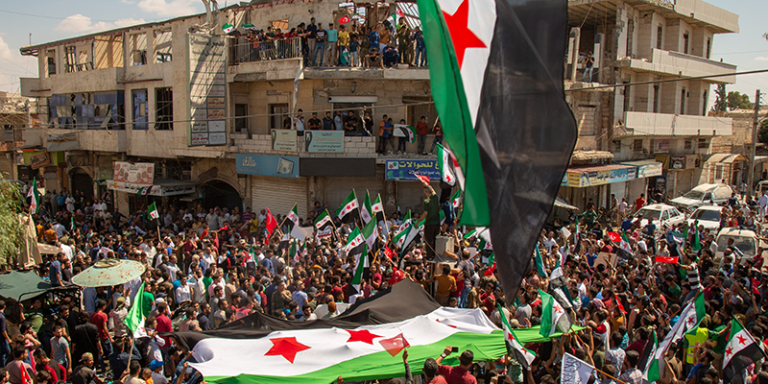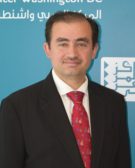
As the Syrian regime of President Bashar al-Assad mounts a final campaign to conquer opposition-controlled Idlib province in the northwest, the country suffers from social divisions and physical destruction that will stymie its growth and civic peace for decades to come. In addition, the presence of foreign troops on its soil renders Syria an open battlefield for the different agendas of disparate players. In fact, Assad’s is a pyrrhic victory over an opposition that is unlikely to accept the continuation of authoritarianism for much too long. One thing is sure, however: the Syrian regime will always be able to count on its original base of support, the Alawite community, to preside over the country after the ignominious end of its devastating civil war.
Social Divisions
For all intents and purposes, Syria has become a divided country. Syrians living in areas in the north such as Idlib province and the Hama and Aleppo countryside refuse to return to being governed by the Syrian regime. They and many of their men joined the Free Syrian Army and other opposition factions. Recent battles there between opposition forces and Syrian and Russian troops indicate that these factions are ready to fight until the end. This is the result of the regime’s reestablishing control over Daraa province in the south and the Eastern Ghouta area near Damascus as part of a so-called reconciliation process.
For all intents and purposes, Syria has become a divided country. Syrians living in areas in the north such as Idlib province and the Hama and Aleppo countryside refuse to return to being governed by the Syrian regime.
Assad accepts only blind obedience and surrender, and he gives his intelligence agencies full authority and control to detain and torture to death anyone whose loyalty is in doubt. The communities in those areas have lost all hope of improving state services like water and electricity supplies. Assad’s strategy is to continue to punish those areas that participated in the uprising against him. As such, Syrians in the north of Syria and the millions of refugees in neighboring countries prefer death by fighting against Assad rather than death under torture or in the Syrian intelligence detention centers.
Majorities of those who live in areas under Assad’s control consider this reality a de facto existence. They are convinced that they have failed to remove him peacefully or militarily and are apprehensive that he has no scruples about using murderous tactics against them including random shelling, barrel bombs, sieges, and torture—simply to ensure his stay in power.
Regime supporters have also benefited from its military victories. Many have resorted to looting of private property of opposition families and displaced Syrians. Today, they carry out blackmail schemes and impose ransoms on families of political prisoners whose numbers are said to be in the hundreds of thousands.
There is no room for reconciliation between Syrians of the north and those under regime control. The current situation is an extension of an unfinished war. Even if it ends militarily, the mass of people who reject Assad will continue to use every means at their disposal to cause instability in the Assad-dominated regions. They have little to lose. Therefore, Syria is most likely to remain in a state of civil war, like a spark that is never extinguished but could be ignited anytime.
Spheres of Influence
The Syrian civil war is not a merely Syrian affair; many regional and international players have played—and continue to play—a critical role in determining its future and even the future of the relationship of Syrians with each other. The interests of the international players in the Syrian conflict did not end the war but rather inflamed it day by day. Today we have the camp of Assad and his allies, Russia and Iran, where there are no democratic values or respect for human rights. Thus, the Assad model of government seems ideal for them: a brutal dictatorship that rules people with murder and torture and has no regard to their needs and interests. On the other side, there are those who supported the Syrian opposition and stood up for the Syrian people from the beginning. But this camp seems to have abandoned its mission.
The Syrian civil war is not a merely Syrian affair; many regional and international players have played—and continue to play—a critical role in determining its future and even the future of the relationship of Syrians with each other.
The United States’ priorities, established under the Obama Administration, have remained the same under the Trump Administration, though with an overdose of apathy and ignorance. At the same time, the division among the Gulf countries after the siege of Qatar in 2017 led to the fragmentation of the Syrian opposition allies. The war in Yemen also created splits and cracks at the regional level. Today, this translates into a second “Arab cold war,” a term coined by the late Malcom Kerr in the 1960s.
With the start of the Arab Spring in 2011, some of the Arab regimes aligned themselves with the Arab revolutions. Such an alignment today is not on the basis of a clash between capitalism and communism, as it was in Kerr’s first Arab cold war; rather, it is between the camp that supports the Arab revolutions and the right of people to choose their rulers and regimes democratically, and the camp supporting dictatorships and Arab military rule, one that has failed to develop Arab countries over the past 50 years.
Saudi Arabia, the United Arab Emirates, and Egypt form an alliance that appears to be influential in reestablishing the old status quo through military rule by supporting General Khalifa Haftar in Libya, the military junta in Sudan, and the Assad regime. The countries that comprise the other camp seem to have no center but support Arab revolutions that express an urgent need for change of governance in the Arab world.
Turkey, which is the leading supporter of the Syrian opposition today and the most steadfast in its position on the Assad regime, has been pressed by its internal challenges, especially the victory of the opposition in recent local elections. The Turkish opposition called for the expulsion of Syrians from Istanbul and for restricting their movement and closing their shops. These policies were implemented after the results of the election in Istanbul in an attempt by the ruling Justice and Development Party (AKP) to regain votes at the next election and pull the rug out from under the opposition’s position on Syrian refugees.
The AKP in Turkey is starting to believe that the Syrian refugees have become a ticking time-bomb that may explode soon, which will perhaps cause the party to lose the next election. It has not lost any elections since coming to power in 2002 and has therefore led Turkey’s pursuit of its strategic interests in northern Syria. Turkey now threatens to conduct a military campaign in northern Syria to reinforce the safe zone and push the Kurdish People’s Protection Units (YPG) forces far from the Syrian-Turkish border. While the US-Turkish relationship is at a crossroads, Turkey fears the implications of losing control over the border. This would empower the Kurdistan Workers’ Party (PKK) since Turkey believes that the YPG is nothing more than an extension of the PKK in Syria. Ankara hopes to create a safe zone to which it could return the Syrian refugees.
The Assad Regime’s Mainstay: Loyalty of the Alawites
A third and final factor helping Syria’s division is the separatist tendencies of groups within Syrian society, which have begun to express their situation clearly and forcefully. These are not only the Kurds but also rising voices within the Alawite community who have provoked violence and hatred against other Syrians through social media.
These voices are now more powerful, and it is clear that Assad listens to them more than any others. They have the greatest influence on the strategy and tactics of the Assad regime and how he deals with other Syrians; indeed, they have shaped the war as a tool of annihilation against the other Syrians. Whatever the cost, it is a war of survival, which has turned the Assad regime into a decentralized militia system not unlike the Khmer Rouge regime in Cambodia in the 1970s.
The Assad regime features an ideological sectarian community that does not seem to care that the president is using chemical weapons and barrel bombs to kill and crush Syrian civilians, health centers, and schools with the nefarious pretext that everyone killed is a terrorist.
The Assad regime features an ideological sectarian community that does not seem to care that the president is using chemical weapons and barrel bombs to kill and crush Syrian civilians, health centers, and schools with the nefarious pretext that everyone killed is a terrorist. This attitude is evident on social media and on banners in public spaces that express support for the Assad regime in its war against the Syrians.
Kurdish separatism also became more apparent with the PKK entering Syria, with Assad’s support, to neutralize the Kurdish National Council, which supported the Syrian opposition. Thus, the minority alliance today in Syria, represented by the pro-Assad separatists and pro-Assad Kurds, poses a real danger to a united Syria. The minority bloc is a threat to Syria’s position and its historical role in the Arab region.
This will lead to a focus on sectarian, ethnic, or linguistic differences in order to view these minorities as the center of permanent threat. Does this create a recipe for another civil war? As we have seen in Lebanon, the civil war only lies dormant until it erupts again.
Internal divisions and external interference have indeed wreaked havoc on Syria and the unity of its people. Syria today can no longer be considered a homeland for all Syrians and its division has become a reality. To be sure, the restoration of its societal and geographic borders seems difficult now, if not impossible.
Photo credit: Abdo Fayyad

